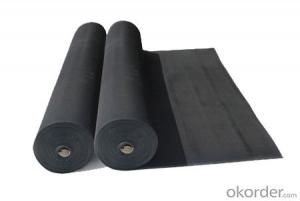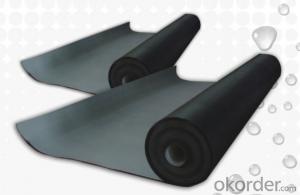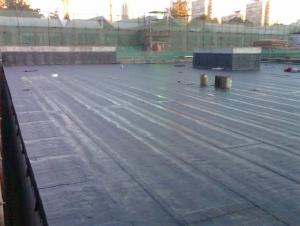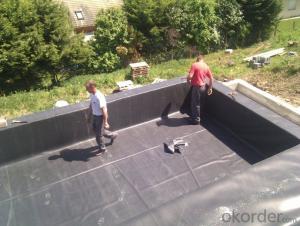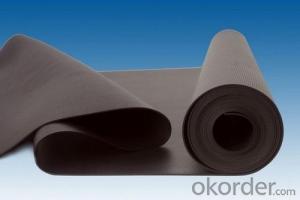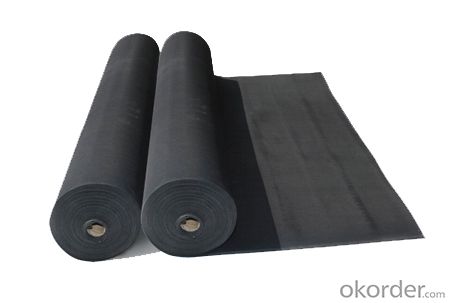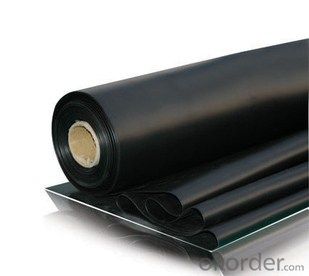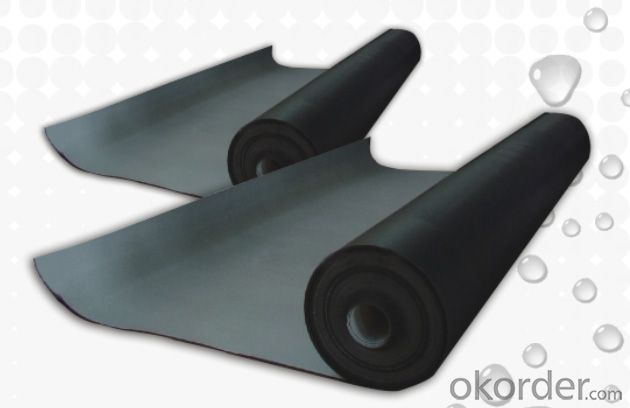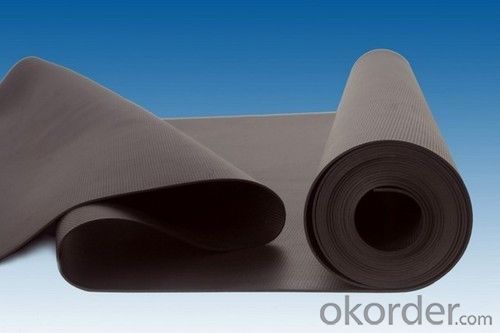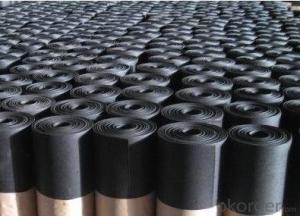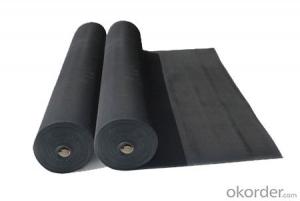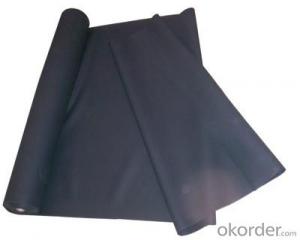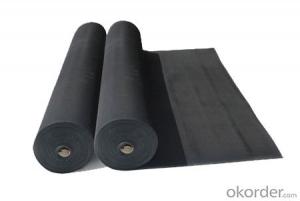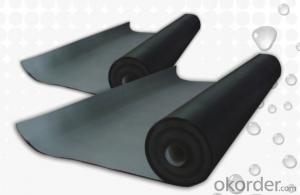EPDM Coiled Rubber Waterproof Membrane in 1.5mm
- Loading Port:
- Shanghai
- Payment Terms:
- TT or LC
- Min Order Qty:
- 10000 m²
- Supply Capability:
- 1200000 m²/month
OKorder Service Pledge
OKorder Financial Service
You Might Also Like
EPDM Coiled Rubber Waterproof Membrane in 1.5mm
Description Of EPDM Coiled Rubber Waterproof Membrane in 1.5mm:
1. EPDM waterproof membrane is made from ternary ethylene-propylene rubber, which is for waterproofing of exposed and non-exposed applications.
2. EPDM waterproof membrane production adopts the world-advanced equipment of cold feeding extrusion and continuous vulcanization technology.
3. EPDM waterproof membrane is of high elasticity among high polymer waterproof materials and becomes a world-popular waterproofing material.
Main Features of EPDM Coiled Rubber Waterproof Membrane in 1.5mm:
1. Excellent physical and mechanical performance
2. High tearing resistance
3. Good deformation adaptability
4. High puncture resistance
5. High aging resistance
6. UV resistance
Specifications of EPDM Coiled Rubber Waterproof Membrane in 1.5mm:
| Material | EPDM Rubber |
| Size | 1.2m (width)*20m (length) or customized, weldable type 2.05m or 4m width |
| Thick | 1.2mm, 1.5mm, 2.0mm |
| Type | Vulcanized & Weldable |
| Pattern | Non-reinforced (homogeneous) |
| Certificate | ISO9001/14001 |
Applications of EPDM Coiled Rubber Waterproof Membrane in 1.5mm:
1.Roofs, Basement, Toilets
2. Industrial and civil building waterproofing
3. Geosynthetic liner for swimming pool, channels, irrigation system
4. Especially suitable for projects with high requirements in durability, anti-corrosion and deformation.
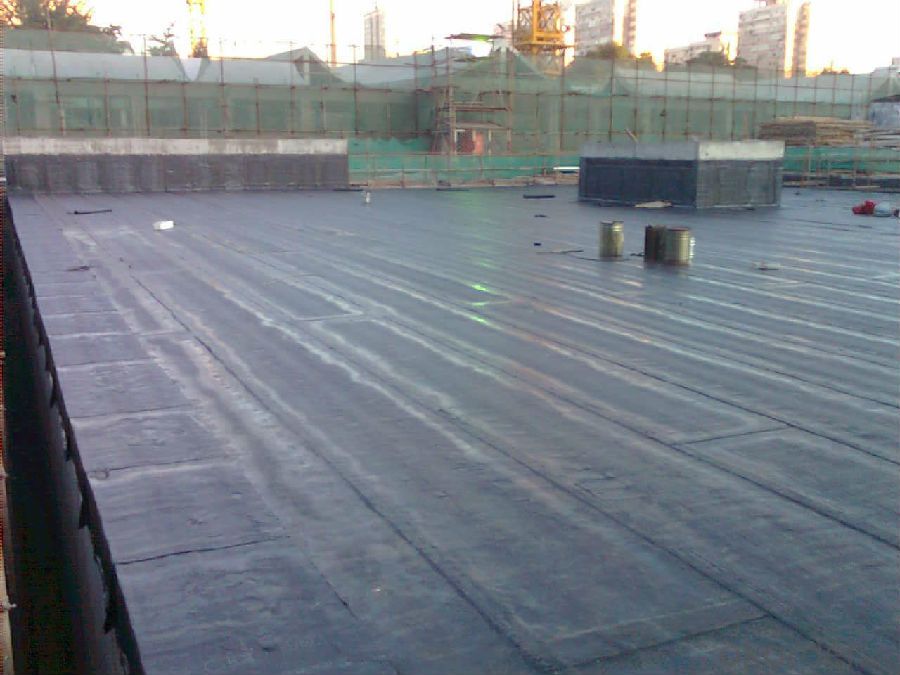
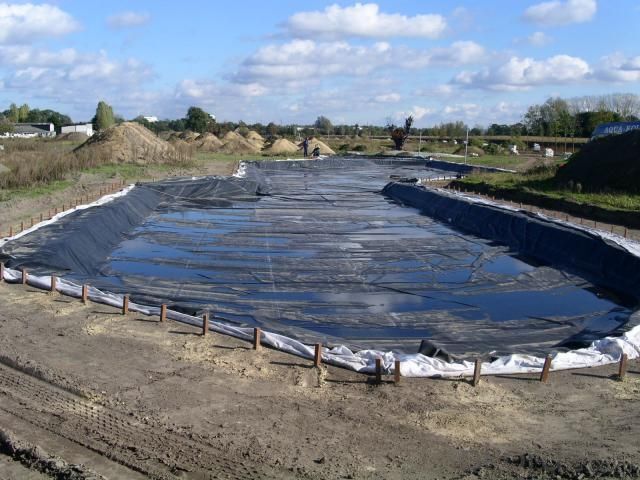

IMages of EPDM Coiled Rubber Waterproof Membrane in 1.5mm:
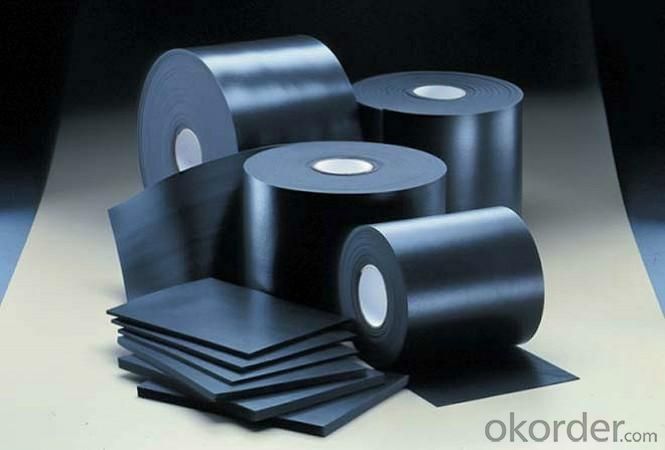



FAQ of EPDM Coiled Rubber Waterproof Membrane in 1.5mm:
1. What are we supplying?
We are specialized in producing Colorful Asphalt Roof Shingle, SBS/APP modified bitumen waterproof membrane, Self adhesive bitumen waterproof membrane, PVC waterproofing membrane, EPDM rubber roofing membrane, Single Component Polyurethane Waterproof Coating, and Spray Polyurea Waterproof Coating
.
2. How Many years experience do we have?
We have been exported to more than 20 countries in the past 15 years.
3. How long do we usually reply your request?
We always reply our customer within 24 hours.
- Q: Can a waterproofing membrane be used for retaining walls?
- A waterproofing membrane is suitable for retaining walls as it helps to prevent water from penetrating and causing damage or structural failure. These membranes, made of materials like rubber, PVC, or bituminous compounds, are installed on the inner side of the retaining wall to create a barrier against water infiltration. In addition to protecting the wall's stability, some membranes also offer resistance to root penetration, UV protection, and flexibility to accommodate movement. However, it is crucial to consider factors such as the type of retaining wall, water pressure, and local climate conditions when selecting the right waterproofing membrane. It is advisable to consult with a professional engineer or contractor to ensure the most suitable waterproofing solution for your specific retaining wall project.
- Q: How does a waterproofing membrane handle temperature fluctuations?
- A waterproofing membrane is designed to handle temperature fluctuations by being able to expand and contract without compromising its effectiveness. It is made of materials that are flexible and can withstand extreme temperatures, ensuring that it remains intact and continues to provide protection against water infiltration.
- Q: Can a waterproofing membrane be used for medical facilities?
- Yes, a waterproofing membrane can be used for medical facilities. Waterproofing membranes are commonly used in construction to protect buildings from water damage and leaks. In medical facilities, it is important to maintain a clean and hygienic environment, and preventing water infiltration and moisture buildup is crucial for this purpose. Waterproofing membranes can be applied to various surfaces including floors, walls, and roofs, to create a barrier against water penetration. This helps to prevent the growth of mold, mildew, and bacteria, which can be harmful to patients and staff. Additionally, waterproofing membranes can also provide protection against chemical spills and contamination, further enhancing the safety and cleanliness of medical facilities.
- Q: How does a waterproofing membrane handle joint movement?
- A waterproofing membrane is specifically designed to handle joint movement to prevent water infiltration and maintain its effectiveness. It achieves this by being flexible and able to accommodate the expansion and contraction of the joints. When joints move due to factors like temperature changes or settling of the structure, a waterproofing membrane should be able to stretch and compress without tearing or losing its waterproofing properties. This is typically achieved through the use of elastomeric materials, such as rubber or synthetic polymers, which have excellent elongation and recovery properties. Additionally, waterproofing membranes may feature reinforcing materials, such as fabric or mesh, to enhance their tensile strength and ability to withstand joint movement. These reinforcements help distribute the stresses caused by joint movement, preventing localized damage and maintaining the integrity of the membrane. Furthermore, some waterproofing membranes include special adhesive properties that allow them to bond tightly to the surfaces they are applied to, including the joint edges. This adhesive bond helps to create a continuous barrier against water penetration, even when joint movement occurs. Overall, a waterproofing membrane is designed to be flexible and durable enough to handle joint movement effectively, ensuring long-term protection against water intrusion and maintaining the structural integrity of the building or structure.
- Q: Can a waterproofing membrane be used for a swimming pool?
- Yes, a waterproofing membrane can be used for a swimming pool. Waterproofing membranes are commonly used in construction to prevent water penetration and leakage. When applied to the walls and floor of a swimming pool, a waterproofing membrane creates a barrier that prevents water from seeping into the surrounding structures. This is crucial for maintaining the integrity of the pool and preventing damage to the surrounding areas. Waterproofing membranes for swimming pools are specifically designed to withstand the constant exposure to water and chemicals, ensuring long-lasting protection.
- Q: Is a waterproofing membrane resistant to UV radiation?
- Yes, a waterproofing membrane is typically resistant to UV radiation. Most waterproofing membranes are designed to be durable and long-lasting, and part of that includes being able to withstand exposure to UV rays. UV radiation from the sun can cause degradation and damage to various materials over time, including waterproofing membranes. However, manufacturers often incorporate UV stabilizers and additives into the membrane's composition to enhance its resistance to UV radiation. These additives help to prevent the breakdown of the membrane's structure, ensuring that it remains effective in preventing water infiltration and maintaining its overall performance for an extended period, even when exposed to direct sunlight. Additionally, some waterproofing membranes may have a protective layer or coating that offers additional UV resistance. It is always recommended to consult the manufacturer's specifications and guidelines to understand the specific UV resistance capabilities of a particular waterproofing membrane.
- Q: Is a waterproofing membrane suitable for both residential and commercial applications?
- Yes, a waterproofing membrane is suitable for both residential and commercial applications. It provides a protective barrier against moisture and can be used in various areas such as basements, roofs, and bathrooms, making it ideal for both residential and commercial buildings.
- Q: Can waterproofing membranes be used on outdoor decks?
- Outdoor decks can indeed benefit from the use of waterproofing membranes. These membranes are highly favored among deck owners due to their ability to effectively block moisture, thus safeguarding the underlying structure from harm. Comprised of durable materials like rubber or PVC, these membranes are specifically crafted to endure exposure to the elements. They are directly applied onto the deck surface, effectively establishing a watertight seal that serves as a protective shield against rain, snow, and other forms of moisture. Moreover, by preventing water damage, rot, and decay, waterproofing membranes contribute significantly to extending the lifespan of the deck. Consequently, incorporating waterproofing membranes into the maintenance routine of outdoor decks proves to be not only a sensible approach but also an efficient one, ensuring the deck's structural integrity and longevity are well-preserved.
- Q: Does a waterproofing membrane affect the structural integrity of a building?
- Typically, the structural integrity of a building is not affected by a waterproofing membrane. Instead, the membrane is specifically designed to safeguard the structural components of the building by preventing water infiltration and subsequent harm. Acting as a barrier against water penetration, the waterproofing membrane ensures that the building remains dry and free from moisture-related issues such as mold, rot, or deterioration. By preserving the building envelope, the membrane aids in maintaining the structural integrity of the building and prolonging its lifespan. It is crucial to note that the installation of a waterproofing membrane must be executed correctly and in accordance with industry standards to guarantee its effectiveness and prevent any potential negative impact on the structure.
- Q: SBS waterproofing membrane sub-class I and II when to use what level to use a secondary level
- For the PE film (aluminum), color sand, shale, fine sand and other four categories; width: 1000mm, 10m long, 15m two specifications; thickness: polyester felt coil 3mm, 4mm, 5mm; fiberglass membrane 3mm, 4mm; glass fiber reinforced polyester felt 5mm Scope: Widely used in industrial and civil construction of the roof, basement, bathroom and other waterproofing works and roof gardens, roads, bridges, tunnels, parking lots, swimming pools and other projects waterproof and moisture. Deformation of the larger project recommended the use of excellent extension of the polyester tire products, other buildings should choose a relatively economical glass fiber products. So look at the temperature and then choose.
Send your message to us
EPDM Coiled Rubber Waterproof Membrane in 1.5mm
- Loading Port:
- Shanghai
- Payment Terms:
- TT or LC
- Min Order Qty:
- 10000 m²
- Supply Capability:
- 1200000 m²/month
OKorder Service Pledge
OKorder Financial Service
Similar products
Hot products
Hot Searches
Related keywords
